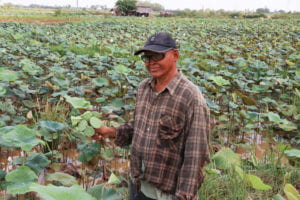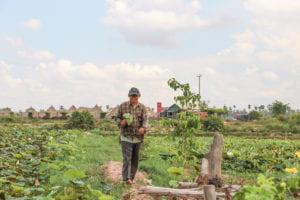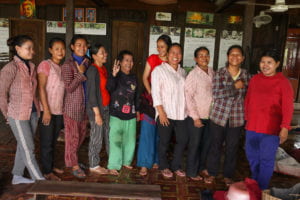16 hours’ worth of bus rides and a day later, we arrive in Siem Reap.
Crossing the thailand-cambodia border was no easy feat. The little in-between town was filled with people yelling and engines blaring; the lone traveller would surely be no match against the criss-crossing alleys and misleading dirt footpaths that all seemed to lead to the arrival checkpoint. Memories of it include the intense smoke and heat, and the 100 baht we had to pay the immigration officers to get across the border. (Kimberly, on our daily expenses, wrote the words “corruption-300 baht”. Its not a lot of money in a sense, but its still something that we weren’t used to as Singaporeans with “the best passport in the world”)
The bus rides have been long and winding so far, but also a great time for reflection and some sleep. Our experiences with the artisans in Phrae have left us with wide-eyed wonder for the hidden communities and trades that we never considered previously. We were awed by the knowledge of the ladies we talked to about both natural indigo dyes (Hom) and weaving fabric, and their almost instinctual connection to their surrounding nature and process. Process, for them, is something slow, thoughtful and dignified – it was something that gave them economic benefit and value, as well as something that gave their life purpose. Artisanship is as much about the people as it is about the final product – the artisans, their friendships with each other, and the support it gives to their families and loved ones, as well as the wider communities these sustainable processes benefit.
Artisanship becomes a far wider concept than we could possibly frame within a singular definition. It is both a product and process, and it concerns both the beginning, the middle and the end of the production process. Yet for the people at Mai Kam Fai, it was a way of life, a living wage, and an intimate community of women. Artisanship was also “folk wisdom” – knowledge passed down from their ancestors that they strove to preserve and pass on,
So here in Siem Reap we were excited, but cautious. After our experiences with the weaving community in Mai Kam Fai, we wondered how Siem Reap would be like. We were visiting Samatoa Lotus Textiles, which was a far more international brand than Mai Kam Fai. What would be their focus? How would they differ from what we had already seen? Sometimes, the fear lies in not liking what we might see.
My scepticism faded after conversing with the owner of Samatoa. A Frenchmen who began a lotus thread weaving workshop in Cambodia, Awen told us that his main concerns were the natural environment, and the process of craft. One thing that struck me was his belief that our human processes should fit and adapt to our surrounding environment, rather than the other way around. This was evident in the practice of the artisans and thread weavers there – I remember staring, mouth agape, when I saw the women pulling apart lotus stems to reveal the many microfibres within them, and then pulling them and rolling them into strong looking white thread. A loom stands in a corner and two women sit on it, weaving long rolls of fabric. All from the lotus stems!
I was shocked to see how the tiny fibres in between lotus stems could form such strong, beautiful fabric. The women worked simply in a wooden workshop, shaded from the sun, with knives to cut the lotus stems and water to wet the thread. “A lotus is a living thing, so water is an intrinsic part of the process,” says Awen. The process was unbelievably simple, and ingenious. Typically, lotuses would be harvested in Cambodia for the flower and the seed. The stems would be discarded or composted, but now the stems have led to sustainable fabric being produced, and more women working in safe conditions with a fair wage. It is amazing to see how thinking alongside nature, and adapting our processes to our natural environment, could have such great results.
The loveliest thing, I think, was to see the circular economy at work in this workshop. The focus on process was evident in every small step in the process of making lotus textiles. Yesterday, we saw the lotus stems being turned into thread, than fabric. Today, we visited the nearby lotus farm where Samatoa works with farmers to get their lotus stems. The farmer was a lovely bespectacled old man with a dog named “Shorty” in Khmer. He was a jolly man who laughed a lot at us young girls with our cameras and equipment. He told me how he had to stay in a hut near his farm so he could make sure no one stole his lotuses. Because it was summer season, he was using some of the fields to plant rice, and would only start planting lotuses when the water level rose. Being able to see the origins of the lotus stems, the exact person and farm who grew them, brought me unexpected joy and warmth. It was the first time I could safely see each and every single person who contributed to the making of my clothes, and recognise their simple yet important stories.
 I think the farmer was intrigued by my curiosity, and he went around his farm to get me a bunch of lotuses so I could eat its seeds. I wish I got his name! (and not just the name of his dog) But in the moment I was too busy trying to convey with my nods and smiles that we were immensely grateful he let us tour his farm and talk to him, and basically give us the time of day!
I think the farmer was intrigued by my curiosity, and he went around his farm to get me a bunch of lotuses so I could eat its seeds. I wish I got his name! (and not just the name of his dog) But in the moment I was too busy trying to convey with my nods and smiles that we were immensely grateful he let us tour his farm and talk to him, and basically give us the time of day!
A lotus bouquet full of edible seedy goodness!
Of course, my team and I have recognised over the trip that our goal is not to “convert” everyone to artisanship. Artisanal goods are still considered expensive and inaccessible to the usual mall crowd. But we have come to see it as more than just a good, but a concept and way of viewing consumption and production. Artisanship is a lens we can use to view the world around us – placing process, rather than product, at the forefront of our considerations. The question “who made my clothes” will no longer be a far-off concept but the first one that comes to mind when we finger a fabric. It is a way of thinking that reminds us that there are always people and communities behind the final products we use and see, and that they are not as far away or as unrelatable as might think.
These are the girls who work at Samatoa lotus textiles. Most of them make thread, some of them weave. (I told them to do a funshot!)
